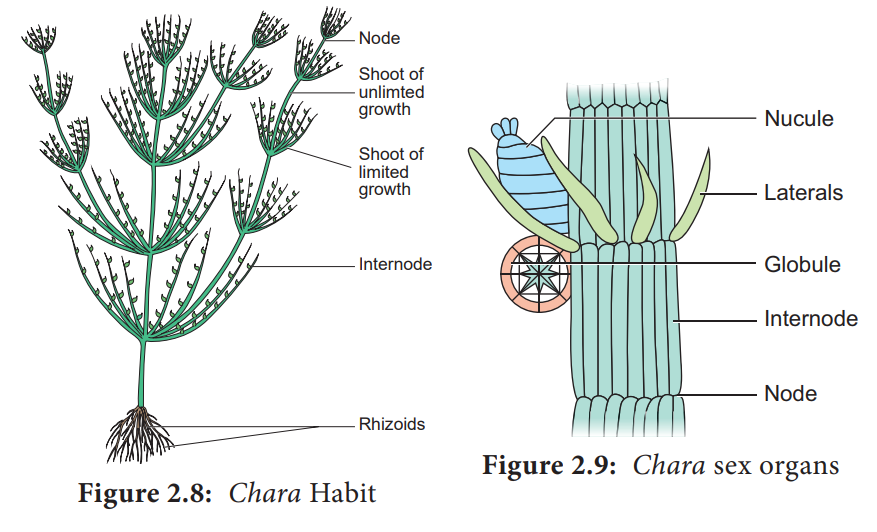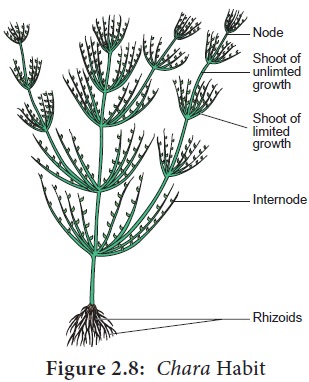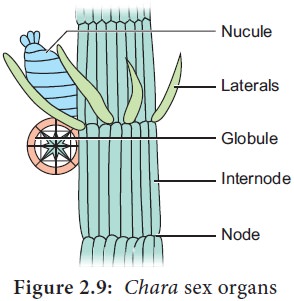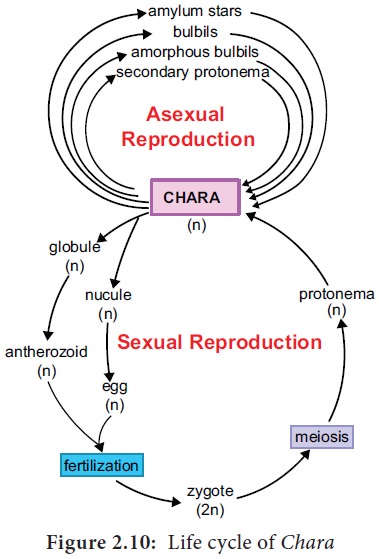Chapter: 11th Botany : Chapter 2 : Plant Kingdom
Chara - Algae

Chara
![]()
![]()
![]()
Class – Chlorophyceae
Order – Charales
Family – Characeae
Genus – Chara
Chara is
commonly called as ‘ stone wort’ It
is a submerged aquatic freshwater alga growing attached to the mud of the lakes
and slow running streams. Chara baltica
grows in saline water. The thallus is often encrusted with calcium and
magnesium carbonate.
Thallus structure
The plant body is multicellular, macroscopic and is
differentiated into main axis and rhizoids. The rhizoids are thread-like,
multicellular structures arise from the lower part of the thallus or peripheral
cells of the lower node.They are characterised by the presence of oblique
septa. The rhizoids fix the main axis on the substratum and helps in the
absorption of salts and solutes (Figure
2.8).

The main axis is branched, long and is
differentiated into nodes and internodes. The internode is made up of an
elongated cell in the centre called axial cell or internodal cell. The axial
cell is surrounded by vertically elongated small cells which originate from the
node. They are called cortical cells. In C.
wallichii and C. corallina the
cortical cells are absent. Three types of appendages arise from the node. They
are 1. Branches of limited growth 2. Branches
of unlimited growth 3. Stipuloides. The growth of the main axis and its
branching takes place by the apical cell.
The nodal cells are uninucleate with few
ellipsoidal chloroplasts. The intermodal cells are elongated and possesses a
large central vacuole, many nuclei and numerous discoidal chloroplasts.
The cytoplasm is divided into outer ectoplasm and
inner endoplasm. The endoplasm shows cytoplasmic streaming.
Reproduction
Chara reproduces
by vegetative and sexual methods.
Vegetative reproduction takes place by Amylum stars, Root bulbils, Amorphous
bulbils and secondary protonema.
Sexual reproduction - Sexual reproduction is
Oogamous. Sex organs are macroscopic and are produced on the branches of
limited growth. The male sex organ is called Antheridium or Globule and the
female sex organ is called Oogonium or Nucule (Figure 2.9). The Nucule is located above the Globule. The
antheridium is spherical, macroscopic and its wall is made up of eight cells
called shield cells. The antheridium has spermatogenous filaments. These
filaments produce antherozoids. The nucule is covered by five spirally twisted
tube cells and five coronal cells are present at the top of the nucule (Figure
2.9). The centre of the nucule

At maturity the tube cells
separate and a narrow slit is formed. The antherozoids penetrate the oogonium
and one of them fuses with the egg to form a diploid oospore. The oospore
secretes a thick wall around and germinates after the resting period. The
nucleus of the oospore divides to form 4 haploid daughter nuclei of which,
three degenerate. The oospore or zygote germinates to produce haploid
protonema. The plant body of Chara is

Related Topics